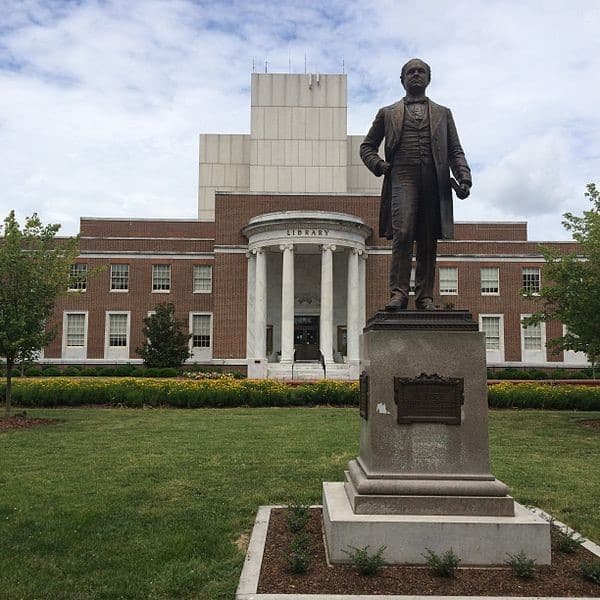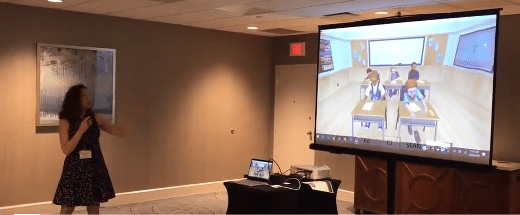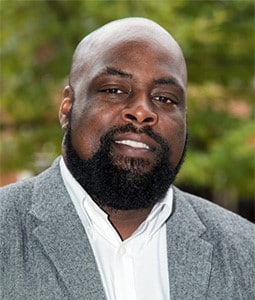07 Nov2019
By Michele Back
 This article originally appeared in the Language Educator and is reprinted with permission from the American Council on the Teaching of Foreign Languages.
This article originally appeared in the Language Educator and is reprinted with permission from the American Council on the Teaching of Foreign Languages.
The ability to collaborate and advocate beyond the classroom and across stakeholders, from department chairs to administrators to parents, is a crucial teacher leadership skill. Moreover, the critical shortage of world language teachers, combined with the diminishing number of U.S. students taking world language courses, means that teacher candidates in this content area must be strong advocates for their own profession from the moment they step into the classroom.
During my time as the world language advisor and methods instructor at the University of Connecticut’s Neag School of Education, I have become increasingly preoccupied with the scarcity of world language teacher candidates, especially as compared to other content areas. I have wondered how our current candidates could apply their emerging leadership roles in ways that would encourage K–12 students to both continue learning languages and to also consider careers in world language education.
07 Nov2019
By Adam Goldstein

The Cherry Creek School District (CCSD) is working with the Peabody College of Education and Human Development at Vanderbilt University to build bridges for the educators and counselors of the future. Cherry Creek chose Vanderbilt Peabody because of their commitment to excellence in developing transformative educators. You can learn more about Vanderbilt Peabody or refer aspiring educational leaders by visiting the website.
Beginning in 2020, the district will host five to eight students from Vanderbilt Peabody for an immersive, 6-day exploratory visit through a new partnership, “Vanderbilt Peabody Peeks at Creek.” Students pursuing their master’s degree in education and those enrolled in counseling programs at the university will be welcomed to the Cherry Creek School District, which spans 108 square miles across the Denver metro area. These students will have the chance to attend an interactive job fair, meet directly with principals and administrators, and tour a district that comprises 42 elementary schools, 11 middle schools, 8 high schools, 1 magnet school, and 3 charter schools. The district also includes the Cherry Creek Innovation Campus, a state-of-the-art facility designed to connect high school students with career and technical education for the 21st century. At the end of their visit to CCSD, Vanderbilt Peabody students will have skills, experience, and personal connections that will help pave the way to a career in education. What’s more, they will head back to the Peabody campus as ambassadors for the Cherry Creek School District and firsthand witnesses to its dedication to excellence.
07 Nov2019
By Leslie T. Fenwick
 This article, written by AACTE Dean of Residence Leslie T. Fenwick, originally appeared in the Washington Post Valerie Strauss column and is reprinted with permission.
This article, written by AACTE Dean of Residence Leslie T. Fenwick, originally appeared in the Washington Post Valerie Strauss column and is reprinted with permission.
“The Problem We All Live With” is the title of the famed Norman Rockwell painting inspired by the story of Ruby Bridges and school integration. In 1964, Rockwell created the painting for the 10th anniversary of the Brown v. Board of Education legal decision that declared state laws establishing separate public schools for black and white students were unconstitutional. The subject of Rockwell’s painting was inspired by Ruby Bridges, who was just 6 years old (born four months after the May 1954 Brown decision) when she integrated the all-white William Frantz Elementary School in New Orleans.
The rabid violence hurled at young Ruby (mainly that day by white women on the scene) is represented in Rockwell’s painting by a racial slur, the letters KKK and a splattered tomato — all appearing on the wall behind Ruby as she marches forward. Despite this terrorism, innocent Ruby walks close on the heels of the front two guards into an undeterrable future. The painting is triumphant. Ruby’s right to attend an American public school unshackled by segregation was ensured by the federal government and, that day, warranted the protection of U.S. federal marshals.
07 Nov2019
By California State University Monterey Bay
 California State University Monterey Bay (CSUMB) has been selected to receive funding under the U.S. Department of Education’s Teacher Quality Partnership (TQP) program in the amount of $4,849,320; $2.2M of which will go directly to student scholarships.
California State University Monterey Bay (CSUMB) has been selected to receive funding under the U.S. Department of Education’s Teacher Quality Partnership (TQP) program in the amount of $4,849,320; $2.2M of which will go directly to student scholarships.
The award, expected to span over a total of five years, will also help fund a project entitled Preparing Observational Practitioners through Partnerships Yearlong (POPPY) and support CSUMB partnerships with eight school districts across Monterey County, further advancing the “grow your own” model of teacher preparation.
06 Nov2019
By Clay Smith
 Collaborative. Encouraging. Communicative. Supportive. Empowering. These are characteristics that contemporary educator preparation programs are committed to building within their traditional teacher candidates. For co-teaching teams, however, these traits are more than preferred; they are essential to success.
Collaborative. Encouraging. Communicative. Supportive. Empowering. These are characteristics that contemporary educator preparation programs are committed to building within their traditional teacher candidates. For co-teaching teams, however, these traits are more than preferred; they are essential to success.
Co-teaching is an innovative pedagogical model adopted to maximize instructional impact and engagement amongst preservice and in-service teachers. Thanks to the support of the AACTE, the “Co-Teaching in Clinical Practice” Topical Action Group (TAG) is able to advocate for co-teaching and support co-teachers in schools throughout the nation.
06 Nov2019
By Jerrica Thurman
 You may now access online the lineup of more than 300 sessions at the 2020 Annual Meeting through the AACTE Event Planner. Take advantage of this all-in-one tool to help plan your conference experience with a few easy clicks!
You may now access online the lineup of more than 300 sessions at the 2020 Annual Meeting through the AACTE Event Planner. Take advantage of this all-in-one tool to help plan your conference experience with a few easy clicks!
To start selecting sessions to attend, visit planner.aacte.org. Once you have logged in, sort through the hundreds of sessions by searching titles, descriptions, presenter names, locations, and other fields. You can also filter sessions by the four conference strands as well.
06 Nov2019
By Hannah Astin
 This article originally appeared in The Carolinian and is reprinted with permission.
This article originally appeared in The Carolinian and is reprinted with permission.
With a new multi-million-dollar grant, UNC-Greensboro’s (UNCG) School of Education will create a new teaching program focused on bringing high-tech thinking to two rural North Carolina counties.
The 5-year, $6.1 million grant comes from the Teacher Quality Partnership grant program under the United States Department of Education.
UNCG School of Education will use the grant money to establish the Piedmont Teacher Residency Partnership. The Partnership will train new teachers in new technology and problem solving, and the teachers will be placed in some public schools in Rockingham and Surry counties.
06 Nov2019
By Jerrica Thurman

AACTE is excited to announce the release of its new video series on Diversity, Equity and Inclusion in educator preparation. The videos address a wide variety of topics ranging from promising practices for recruiting and retaining teachers of color, to the importance of culturally relevant teaching for growing the special education teacher pipeline, and also promoting equal access to quality teachers, just to name a few.
The video series exemplifies the Association’s new strategic priority to promote diversity, equity and inclusion. AACTE and its members value the diversity of students, their families, and educators; equity in access to high quality instructional environments; and the inclusion of all students, defined as access and opportunity in PK-20 classrooms.
05 Nov2019
By John Kuykendall

Our nation and the entire world are changing rapidly. With the rise of threats to our children’s safety like depression, lack of mental health resources, familial disruptions, and school violence and shootings, it is imperative that we equip teachers and school personnel with the tools they need to recognize and respond to all students, in all classrooms.
In today’s schools, students are suffering from a variety of issues; one that arises too often is mental health. Unfortunately, it is not always apparent what these students are experiencing. Depression is rampant. Emotional stress stems from a variety of external factors including depression, divorce, social media anxiety, lost friendships, bullying or simply feeling out of touch with others. It is imperative, now more than ever, that our teachers are prepared to notice when students are experiencing these types of trauma. Trauma informed practices allow teachers to be trained well beyond the obvious clues and prepares them to be aware of early, less apparent warning signs, so they can successfully and swiftly intervene to help a student in need.
04 Nov2019
By Diana Lambert

This article and photo originally appeared in EdSource and are reprinted with permission.
Jennifer Garza, a 7th grade English teacher at Green Acres Middle School in Visalia, was teaching on an intern credential in 2015.
Two federal grants totaling over $9.4 million will help California recruit teachers and mental health professionals to rural schools.
The U.S. Department of Education awarded the five-year grants to the California Center on Teaching Careers, an organization started in 2016 to help solve the persistent teacher shortage. The center is run by the Tulare County Office of Education, in partnership with California State University Bakersfield.
04 Nov2019
By Jacqueline E. King, Ph.D.
The 2019 election for the AACTE Board of Directors is now underway through November 29. Four seats will be decided via online voting:
- Two at-large seats
- One representing the Association of Independent Liberal Arts Colleges for Teacher Education (AILACTE)
- One representing the Council of Academic Deans from Research Education Institutions (CADREI)
01 Nov2019
By Jacqueline Rodriguez
 AACTE President and CEO Lynn Gangone and I had the privilege of demonstrating the Association’s commitment to Inquiry and Innovation during a recent visit to New Orleans.
AACTE President and CEO Lynn Gangone and I had the privilege of demonstrating the Association’s commitment to Inquiry and Innovation during a recent visit to New Orleans.
AACTE collaborated with member institution, the University of Central Florida, to present the TeachLivE™ Lab (TLE Lab) to members of Grantmakers for Education during their recent conference in Louisiana. Grantmakers for Education is the nation’s largest and most diverse network of education grantmakers dedicated to improving educational outcomes and increasing opportunities for all learners.
01 Nov2019
By Jane E. West

This blog post is written by AACTE consultant Jane West and is intended to provide update information. The views expressed in this post do not necessarily reflect the views of AACTE.
It’s been quite a week in DC. The most impressive news is having our home team—the Nationals—win the World Series, despite their substantial underdog status. Other than that, the House voted to proceed officially with the impeachment process on a totally partisan basis—and that promises to suck the oxygen out of any sort of Congressional agenda for months.
Are we Headed to a Government Shutdown … Again?
While the Senate made progress on funding bills this week, big hurdles remain. The Senate passed a package of four appropriations bill with a bipartisan vote of 84-9, the first funding bills to pass the Senate. However, Senate Democrats blocked movement on the package of two large spending bills: Defense and Labor/HHS/Education. They are not happy that President Trump is insisting on funding for his border wall and that the Labor/HHS/Education bill’s spending level is so low.
01 Nov2019
By Preston Thorne
 This op-ed article originally appeared in The State and is reprinted with permission.
This op-ed article originally appeared in The State and is reprinted with permission.
I was wasting time on Twitter when I came across a post that stopped me mid-scroll. The original post posed a question: How many black male educators did you have in kindergarten through 12th grade.
One of my former students chimed in with a shocking number: 1…Coach Thorne.
That’s me; that’s who I was. I taught social studies at Blythewood High School for 11 years and was an assistant football coach.
At first glance, the number 1 seems to be an indictment and a referendum on what we in education circles have known forever—we need more black men in the classroom. But upon further inspection, with a little critical analysis, I believe there is power in one.
Statistics tell us that having just one African American teacher in elementary school reduces drop-out rates among black boys by nearly 40% and increases their recognition as gifted students.
But stats don’t tell the story.
31 Oct2019
By Cecelia Monto

The need to diversify the teaching workforce is well documented (Darling-Hammond, 2010). Student demographics across the United States have significantly changed in the last 20 years, with particular increases in bilingual and Hispanic student populations (Aud, Hussar, Kena, Bianco, Frohlich, Kemp, &Tahan, 2011). However, the teaching workforce has not reflected the shift in student demographics, and a growing gap has emerged between the racial and ethnic backgrounds of students and teachers. Because community colleges serve a high percentage of diverse students, a community college pathway into teaching represents a promising approach for increasing the diversity of the teaching workforce.
 This article originally appeared in the Language Educator and is reprinted with permission from the American Council on the Teaching of Foreign Languages.
This article originally appeared in the Language Educator and is reprinted with permission from the American Council on the Teaching of Foreign Languages.


 This article, written by AACTE Dean of Residence Leslie T. Fenwick, originally appeared in the Washington Post
This article, written by AACTE Dean of Residence Leslie T. Fenwick, originally appeared in the Washington Post  California State University Monterey Bay (CSUMB) has been selected to receive funding under the U.S. Department of Education’s Teacher Quality Partnership (TQP) program in the amount of $4,849,320; $2.2M of which will go directly to student scholarships.
California State University Monterey Bay (CSUMB) has been selected to receive funding under the U.S. Department of Education’s Teacher Quality Partnership (TQP) program in the amount of $4,849,320; $2.2M of which will go directly to student scholarships. Collaborative. Encouraging. Communicative. Supportive. Empowering. These are characteristics that contemporary educator preparation programs are committed to building within their traditional teacher candidates. For co-teaching teams, however, these traits are more than preferred; they are essential to success.
Collaborative. Encouraging. Communicative. Supportive. Empowering. These are characteristics that contemporary educator preparation programs are committed to building within their traditional teacher candidates. For co-teaching teams, however, these traits are more than preferred; they are essential to success.  You may now access online the lineup of more than 300 sessions at the 2020 Annual Meeting through the
You may now access online the lineup of more than 300 sessions at the 2020 Annual Meeting through the  This article originally appeared in
This article originally appeared in 


 AACTE President and CEO Lynn Gangone and I had the privilege of demonstrating the Association’s commitment to
AACTE President and CEO Lynn Gangone and I had the privilege of demonstrating the Association’s commitment to 
 This op-ed article originally appeared in
This op-ed article originally appeared in 